Blagdon Lake Birds
February 2013 News
50 Years Ago; Robin J. Prytherch had a remarkable year at Blagdon Lake in 1963, finding a Purple Heron Ardea purpurea in May, the first for Somerset, and a Pied-billed Grebe Podilymbus podiceps in December, which was the first for Europe! Coincidentally, George Sweet and Michael Wright found a singing Aquatic Warbler Acrocephalus paludicola, the second record for Somerset and first for the lake, on the day after Robin found the Purple Heron.
Friday 1st February [A blustery and mainly dry day]
Since the snow and subsequent run-off which coloured the water at Top End, Common Coot Fulica atra numbers have noticeably dropped. So it is with Aythya ducks today, with both Scaup spp. appearing to have moved on as well. However, on a positive note, I saw the elusive Black-necked Grebe Podiceps nigricollis off Wood Bay Point by the flooded bushes at about 1400 hrs. The Canada Goose Branta canadensis flock appears to have diminished as well (no sign of orange 'DL'), and I only saw 2 Barnacle Geese Branta leucopsis with them at Rainbow Point.
Saturday 2nd February [Bright and sunny]
Today was one of those rare occasions when, having spent some time along the south shore this morning in the raw north wind, I have little to report from the waterside. There were even fewer wildfowl, so they are clearly on the move and as if to prove the point, a second pair of Mute Swans Cygnus olor has returned to the lake, in Long Bay.
The Lesser Scaup appears to have gone back to South Wales, not Flintshire as I first supposed because that bird was a 1st-winter, apparently. I am a little surprised that it left at the beginning of February because their Spring migration is usually given as late February-March (e.g. Kear, 2005), and this is certainly borne out by the pattern of appearance at the lake in Spring.
Sunday 3rd February [Low cloud and grey all day]
I walked the whole south shore and back at lunchtime and saw the Black-necked Grebe Podiceps nigricollis at Burmah Road on the way back. The Canada Geese Branta canadensis count is down to 45 as birds are moving away to breed. It looks like it's going to be hard going this month until the migrants arrive!
Monday 4th February [Cold with a strong westerly wind]
It was a surprise to see a Common Sandpiper Actitis hypoleucos on the dam wall, having not seen it since the 21st January and the pair of adult Goosanders Mergus merganser were swimming east along the North Shore in the waves racing down the lake. I didn't see the Black-necked Grebe despite looking for quite a time, but there were two huge tractors 'tidying' the roadside and hedges in readiness for the new fishing season which may have caused it to take cover.
A third check of the gulls didn't produce anything exceptional though I did spot a second adult ♂ Goosander Mergus merganser in Butcombe Bay while I was scanning.
Tuesday 5th February [A strong westerly wind was sweeping down the lake. Dry.]
The Common Sandpiper Actitis hypoleucos was on the dam again at lunchtime and I eventually spotted the Black-necked Grebe Podiceps nigricollis in the flooded trees at Wood Bay Point. There were 2 adult ♂ and 2 adult ♀ Goosanders Mergus merganser in Butcombe Bay but nothing of note in the gull roost despite the really strong westerly winds we've had over the last 24 hours.
I found the fungus known as Scarlet Elfcup Sarcoscypha sp. which is a first for the lakeside. It grows on dead wood decaying on the ground. There is a clade of very similar species which means that to identify it to species level, it will have to be microscopically examined. It's very pretty though, growing in moss.
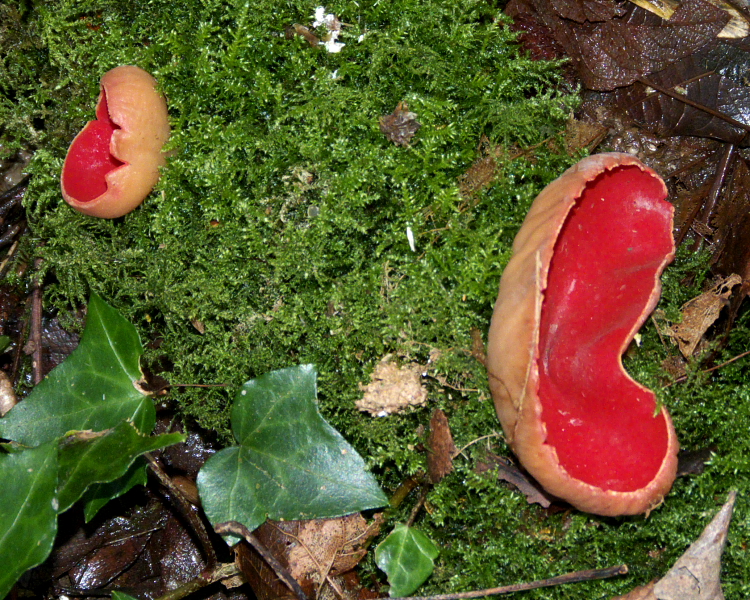
Wednesday 6th February [Dry, with a chilly blast from the north.]
The Black-necked Grebe Podiceps nigricollis was tucked in among the sleeping Common Pochards Aythya ferina in the lee of Holt Copse but I couldn't see the Common Sandpiper or Goosanders when I checked the gull roost. The days are certainly lengthening now. I left the lakeside at 1650 hrs and most of the larger gulls were still to arrive from the fields.
An earlier walk down the Yeo from below the Pumping Station took me to Elmley, then Ashey Lane and on the far side there were lots of gulls and circa 100 Northern Lapwings Vanellus vanellus in the fields. I wanted to look at the the river because I was wondering what the chances of us ever getting Dippers Cinclus cinclus back at the Pumping Station were likely to be. They used to breed there until 1932. There was a good flow on the stream but I think it is too deeply cut and doesn't offer many riffles and areas for them to feed, unlike the stream that issues out of Rickford Pond, which looks really good and I know has attracted them in the last 20 years. I shall check it later in the year and have a look at the dragonfly fauna too.
Thursday 7th February [Driving drizzle this afternoon]
I didn't see the Black-necked Grebe Podiceps nigricollis until I looked back from Top End hide towards Holt Copse and as I walked back it was at the west end of Burmah Road. I decided to have a closer look at it through the scope for the first time in ages and I noticed that the golden plumes on the side of the head are starting to come through. I met Paul Williams as I arrived and he said he'd seen 19 Eurasian Siskins Carduelis spinus in Lodge Copse. Neither of us had seen the Common Sandpiper Actitis hypoleucos, that is until I was checking the gull roost and heard it calling. Sure enough it had flown onto the south end of the dam. A pair of adult Goosanders Mergus merganser had also arrived at Spinney Point, presumably to roost on the lake, during the time I'd taken to walk to Top End and back.
Friday 8th February [Showers]
Nothing new to report. The Black-necked Grebe Podiceps nigricollis was at Hellfire Corner, and the Common Sandpiper Actitis hypoleucos still on the dam. This afternoon there were 3 ♀♀ Goosanders Mergus merganser in the middle of Butcombe Bay asleep.
Tomorrow is WeBS count day and Sunday, weather permitting, the Avon Bat Group are coming to check trees on Butcombe Bank for signs of tree bat roosts. There are some species we haven't recorded at the lake yet, that we might find by taking this different approach. Although we won't necessarily expect to see any bats, I'm looking forward to it, I must say. It'll be yet another take on recording wildlife around the site.
This morning I got engrossed in reading the blog of Beverley Hargrove, wife of fellow birder John Hargrove, whom I met at Gambell, St. Lawrence Island in Alaska last June. John was doing his 'Big Year' at the age of 69 and Beverley wrote a regular blog updating the world with how he was getting on. It was a thoroughly entertaining read and brought back memories of many places I have birded in the USA over the last few years. For you listers out there I'd recommend clicking on the link above to follow John's mad journey starting on 1st January 2012 (click on newer post at the bottom of each page to follow the story).
Saturday 9th February [Drizzle and still]
WeBS day meant we had a good look around with five pairs of eyes searching for the hidden gems and we found the Black-necked Grebe Podiceps nigricollis in the flooded trees at Home Bay Point, the Common Sandpiper Actitis hypoleucos on the dam and 5 adult Goosanders Mergus merganser (2 ♂♂) dotted about. What was surprising for me was that there appeared to be a few more Tufted Ducks Aythya fuligula at Top End again today, having said the number had dropped from last months count of 453, and this was borne out by Phil Delve's count of 472. However, Lucy Delve's Common Coot Fulica atra count has gone down in successive months from 1070 to 778 to 463 to 195. Todays totals are on the WeBS Count page. The next count will be made a week late, as I am visiting Trinidad with Daniel Hargreaves on a Trinibats research trip. It is a fascinating island just off the coast of Venezuela with 68, or more, species of bat. I will be taking my camera gear, of course, but it'll mean postponing next months survey until 16th March.
There were Eurasian Siskins Carduelis spinus visiting the feeders at the Lodge and we had at least two on our garden feeders this morning. I put a new nut feeder up at the Hatchery a week or two ago and it has already been damaged by something extracting nuts; I suspected Grey Squirrels Sciurus carolinensis, but today I saw a Western Jackdaw Corvus monedula hanging on it!
Sunday 10th February [Steady rain]
I did not bird at the lake today. Instead, I joined Daniel, Jim and some Avon Bat Group members looking for arboreal bat roosts at the lakeside from 1000-1545 hrs. We found one hole in a Beech Fagus sylvatica that contained a bat skeleton which Daniel tentatively identified as a Daubenton's Myotis daubentonii and several other holes that looked as if they might hold roosting bats but with no direct evidence of them having done so. We checked a known Daubenton's summer roost and the hibernaculum without finding any bats, but there was a Common Pipistrelle Pipistrellus pipistrellus in one of the boxes which was examined from below without opening it. It was an interesting, if rather wet, day.
Monday 11th February [It was trying to sleet this afternoon]
I saw 30+ Eurasian Teal Anas crecca, which is more than I counted on the WeBS, and 19 Common Snipe Gallinago gallinago flushed out of the very wet meadows as I walked along the south side road. I couldn't find either the Black-necked Grebe or Common Sandpiper. Having taken time on Saturday to repair some of the damage to one of the wild flower meadows caused by tractors last week, they were back today, even though we had half an inch of rain yesterday, so I decided to just come home and get away from the place. Richard Mielcarek sent me nearly 7000 duck records yesterday to edit for the 2013 Avon Bird Report - perhaps they'll provide some therapy!
Tuesday 12th February [Mainly overcast with weak sun this afternoon]
I had a drive around this afternoon and didn't see anything worthy of note other than 2 Green Woodpeckers Picus viridis in different areas. My main reason for going was to fill the feeders and count the gull roost. When I got there I saw good numbers (300+) of Common Gulls Larus canus, but they flew off to Chew to roost as usual and later when things had settled, around 1700 hrs, I got the clicker out and tallied 1376 Black-headed Gulls Chroicocephalus ridibundus, 209 Herring Gulls Larus argentatus and 159 Lesser Black-backed Gulls Larus fuscus. There were a handful of Common Gulls left and a couple of adult Greater Black-backed Gulls Larus marinus too. Most of the Herring Gulls appeared to be paired up and in breeding plumage, whereas the Black-headed Gulls are still mainly in winter plumage with just a scattering of dark-headed birds throughout the flock.
Richard Keel kindly emailed to say he'd seen 3 Reed Buntings Emberiza schoeniclus, a Green Woodpecker, 21 Common Woodpigeons Columba palumbus at the dam, 14 Common Goldeneye Bucephala clangula, 3 Goldcrests Regulus regulus and 25 roosting Great Cormorants Phalacrocorax carbo during his visit.
Wednesday 13th February [Wet and very windy]
Early wet snow turned to rain for much of the day, and we had a SSE gale blowing over the Mendips. The wind direction was quite unusual and the small gulls sheltered in Butcombe Bay, while the larger spp. were spread out over the dam end. I didn't see anything unusual among them and neither were there any unusual wildfowl taking cover along the south side of the lake that I could see.
I don't know why it popped into my head just now, but we saw Common Goldeneye Bucephala clangula displaying and mating on Saturday at Butcombe Bay. It's such a lovely sight to see the males throwing their heads back and calling, to impress the gals.
Thursday 14th February [Sunshine and light showers]
It is still very quiet, but the elusive Common Sandpiper Actitis hypoleucos was back on the dam now that the wind has turned back to the west. There were 87 Canada Geese Branta canadensis on Holt Farm and while I was counting them a ♂ Eurasian Sparrowhawk Accipiter nisus flew over. Quite a few Song Thrushes Turdus philomelos were singing in the late afternoon sun as I made my way back home.
Friday 15th February [Sunshine all the way]
I popped down to the Lodge to fill the feeders and then went to WWT Slimbridge with Robin Williams to take pictures of wildfowl. It was lovely to have some decent light for a change. We saw four of the released Common Cranes Grus grus that have returned and lots of waders, but the visiting geese were too far away to photograph. I shall report from the lake again tomorrow.
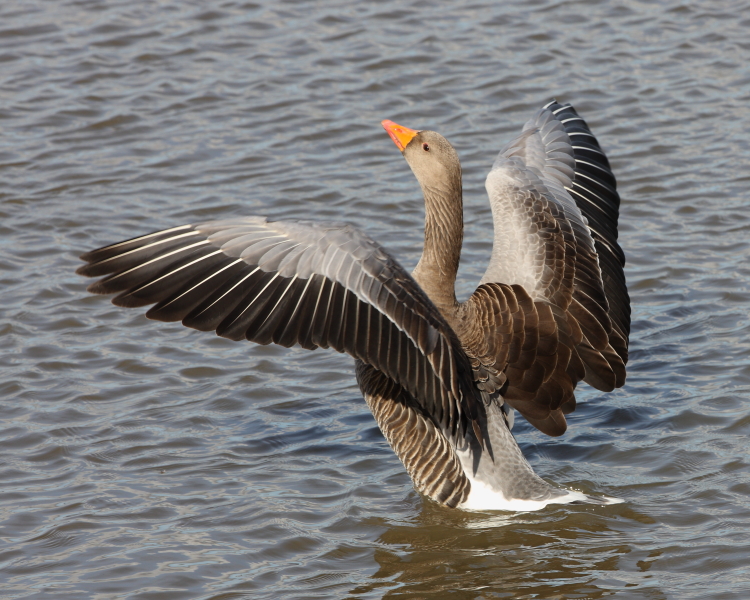
Saturday 16th February [Mild, benign and mainly overcast]
Our wintering Common Sandpiper Actitis hypoleucos was feeding along the water's edge of the dam wall this afternoon and a couple of Northern Ravens Corvus corax flew over cronking. A few bright Lesser Celandines Ranunculus ficaria bespangled the base of the hedgeline along Park Lane and I heard a Mistle Thrush Turdus viscivorus singing nearby. Despite trekking all the way to Top End gate and back and counting 72 Canada Geese Branta canadensis and 49 Eurasian Wigeon Anas penelope there wasn't a whole lot else to report. There's still a few Eurasian Teal Anas crecca and Northern Shoveler Anas clypeata around the flooded margins but numbers are dropping away.
Sunday 17th February [Sunny but cold]
I met Dr Mike and Christine O'Connor this afternoon, who told me they'd seen a Greylag Anser anser (an adult) and 2 Barnies Branta leucopsis in the goose flock, which was quite exciting given how slow the birding has become lately. Sure enough, when I counted the flock, it had grown to 134 Canada's Branta canadensis as well. And, I received news yesterday from John Alridge (in litt.) that the Canada Goose with the orange neckband 'DL', that had been at Blagdon last month, was over at Avon Valley Wildlife Park between Keynsham and Saltford now. We've sent the news on to Beatrice Downing, a PhD student at Exeter University, who is involved in monitoring the movement of these birds that were neck-collared at Cotswold Water Park in July 2012. Mike and Christine also saw a small bat sp. flying around near the Lodge at 1515 hrs.
In yesterday's blog, I very nearly wrote that given that I hadn't seen the Black-necked Grebe Podiceps nigricollis since the WeBS count a week ago, perhaps it had moved on. Despite searching for it on a number of days since, there it was again today at the west end of Burmah Road in the corner with Holt Copse where I last saw it! It's in moult to adult breeding plumage now, so if it sticks around for another month or so, as I hope it will, perhaps we'll see it in all its finery before it leaves.
The wind was in the east again today, so there was no sign of the Common Sandpiper Actitis hypoleucos on the dam when I checked the gull roost.
You may have noticed that I've been updating the navigation around the website, which I'm hoping will make it easier for you to find your way around and get information, particularly about bird records, than hitherto. Today, I've also revised the bat info in line with the bird section, to give it a similar feel.
Monday 18th February [Sunny]
I drove along the south side of the lake when I got back from my walk and, once again, couldn't see the Black-necked Grebe Podiceps nigricollis, but the Greylag Anser anser was still with the Canada Goose Branta canadensis flock (which was actually 135 strong - I forgot to count the resident non-flying bird yesterday). Two feral Barnacle Geese Branta leucopsis were also with them. The wind was still firmly in the east and the Common Sandpiper Actitis hypoleucos was nowhere to be seen either.
I walked more of the Mendip Ring from Sharpham Ponds to Windmill Hill with friends today. Disappointingly, we didn't see the reported Whooper Swans Cygnus cygnus at Sharpham, but there were at least 3 Skylarks Alauda arvensis singing around there.
Tuesday 19th February [Sunny]
I only paid a short visit at the end of the day when I saw the Common Sandpiper Actitis hypoleucos on the dam and the Greylag Anser anser still with the Canada Goose Branta canadensis flock.
I spent most of the day on the Somerset Levels and had a rather fortuitous time catching up with the Pied-billed Grebe (at Ham Wall), 3 Smew (adult ♂ and 2 redheads on Decoy Lake), adult ♂ Hen Harrier, Great White Egret and Whooper Swan (at Catcott Lows). There were at least 650 Golden Plover on Draycott Moor as well.
Wednesday 20th February [Grey and cold]
With the cold easterly blowing along the lake onto the dam there was, predictably, no sign of the Common Sandpiper Actitis hypoleucos or the Black-necked Grebe Podiceps nigricollis. However, the Canada Goose Branta canadensis flock has grown again to 201, and included a probable Greylag x Canada hybrid, the Greylag Anser anser and 2 Barnacle Geese Branta leucopsis. The hybrid goose appears to be the one I photographed on the 6th September 2010. Other sightings included 2 Lesser Redpolls Carduelis cabaret showing low down in the Alders Alnus glutinosa at Hellfire Corner, with a Green Woodpecker Picus viridis and Common Snipe Gallinago gallinago at Long Bay.
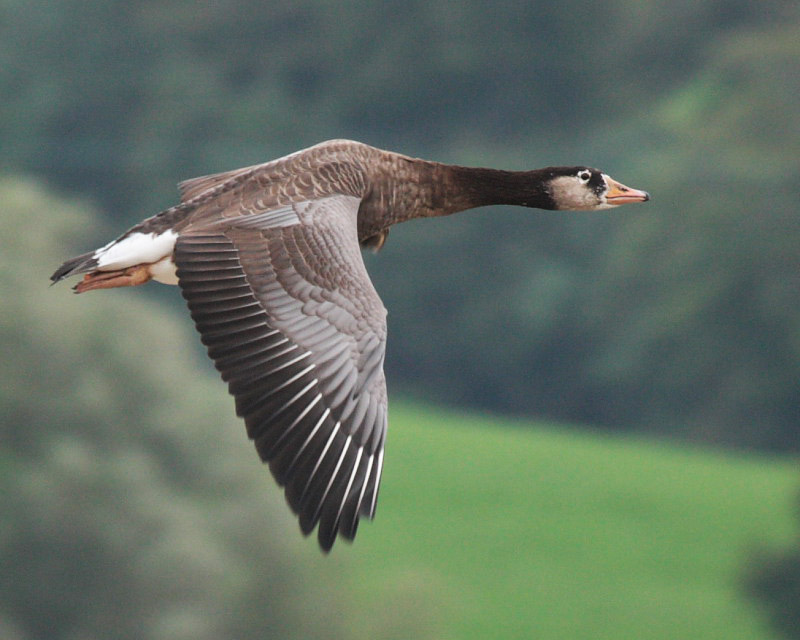
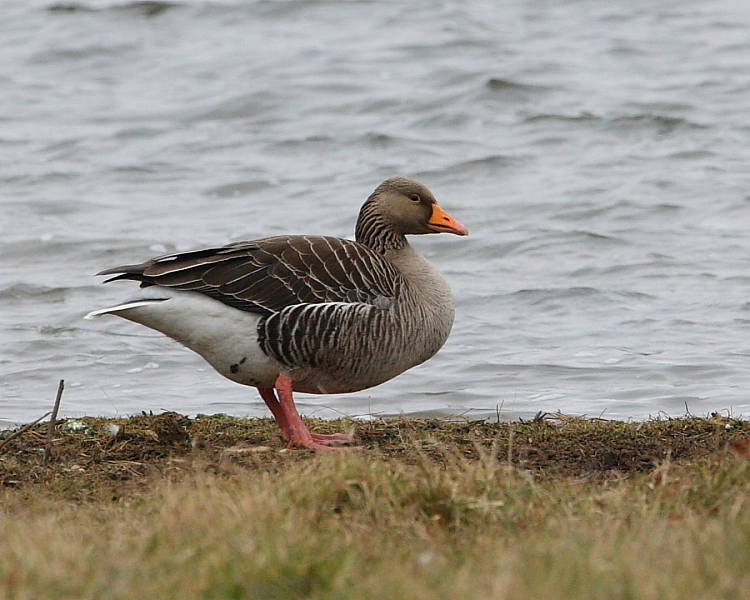
Thursday 21st February [Sunny but bitterly cold with a strong north-easterly breeze]
Much the same fare as yesterday at the lake, with all the geese still present, but no sign of the sandpiper or grebe. Hopefully, I'll have some time to have a good look around tomorrow.
Friends and I walked 9 miles in the Forest of Dean along theWysis Way, from Speculation to the A40 crossing at May Hill today, and kept an eye open for Goshawks and Wild Boar, but we had no luck, only displaying Common Buzzards.
Friday 22nd February [Mainly overcast and bitterly cold]
Surprise, surprise, I spotted the Black-necked Grebe Podiceps nigricollis skulking in the flooded trees at Wood Bay Point (west end of Burmah Road). There had been some turnover among the geese with the Greylag Anser anser still present, but no sign of the distinctive hybrid. There were also 15 Barnacle Geese Branta leucopsis in the throng which included 205 Canada Geese Branta canadensis. In addition to the waterfowl there were a pair of Grey Wagtails Motacilla cinerea at Ubley Hatchery and at least 9 Grey Herons Ardea cinerea by the lake.
Saturday 23rd February [Cold, cold, cold]
I didn't visit the lakeside today. I made a birding visit to the Forest of Dean with some mates where we had a quiet day. We saw just a single Goshawk from New Fancy View, 41 Mandarins on Cannop Pond and some Marsh Tits visiting a feeder there. On the way over, we saw 2 Twite and a Barn Owl at Aust Warth.
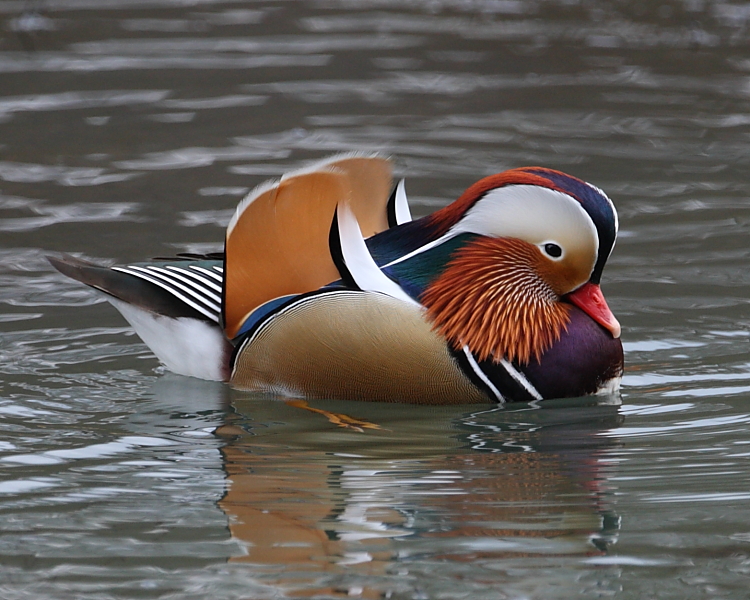
Sunday 24th February [Still cold and grey]
There were fewer Canada Geese Branta canadensis, just 111, and the Greylag Anser anser at lunchtime on Holt Farm and Green Lawn. The water has stopped going over the Spillway and the Common Sandpiper Actitis hypoleucos was on the lip in the relative shelter of Butcombe Bank. I believe I'm right in saying Blagdon is being pumped just now, and there has just been a slight drop from top level over the last week. There were also 4 Northern Lapwings Vanellus vanellus on the dam.
On the way to Bristol Museum for a Bristol & District Moth Group Meeting in the afternoon, I saw about 25 Golden Plovers Pluvialis apricaria in flight on the east side of the A38 by the airport, a traditional site for them.
Monday 25th February [Dismal, grey, with a raw north north-east blow]
I was waiting in for an electrician this afternoon, so this delayed my visit until much later than I'd have preferred, but Lady Luck was on my side because I spotted a Eurasian Bittern Botaurus stellaris low down in a bush sheltering from the wind at 1737 hrs (9th lake record). The Common Sandpiper Actitis hypoleucos was on the dam and the geese were nowhere to be seen until I spotted them at last light sheltering in the lee of the Indian Country bank at Top End. Unfortunately, it was just too dark for me to see if the Greylag was still with them.
Tuesday 26th February [Grey and cold]
The Black-necked Grebe Podiceps nigricollis was at Wood Bay Point again this afternoon around the flooded trees, but I couldn't find the Eurasian Bittern Botaurus stellaris or Common Sandpiper Actitis hypoleucos. The geese had changed around again today with the Greylag Anser anser and 2 Barnacle Geese Branta leucopsis still present. There were 116 Canada Geese Branta canadensis including the bird with an orange neck collar 'DL' back from Avon Valley Wildlife Park. I saw a few Common Snipe Gallinago gallinago, some Great Crested Grebes Podiceps cristatus displaying, a second pair of Mute Swans Cygnus olor at Home Bay (4 birds at the lake now), 12+ Common Moorhens Gallinula chloropus and the regular flock of 200-300 Redwings Turdus iliacus and Fieldfares Turdus pilaris at Top End.
I walked with friends from Windmill Hill on the Poldens to Baltonsborough via Butleigh and saw circa 10 Skylarks Alauda arvensis in a field near Higher Hill Farm and 4 Little Egrets Egretta garzetta near the River Brue.
Wednesday 27th February [Grey and cold]
I didn't get a chance to visit today, but there was belated news from Pete Sinclair of a ♀ Red-breasted Merganser Mergus serrator on Sunday. I've added a picture taken by Pete in the Guests Photo Gallery.
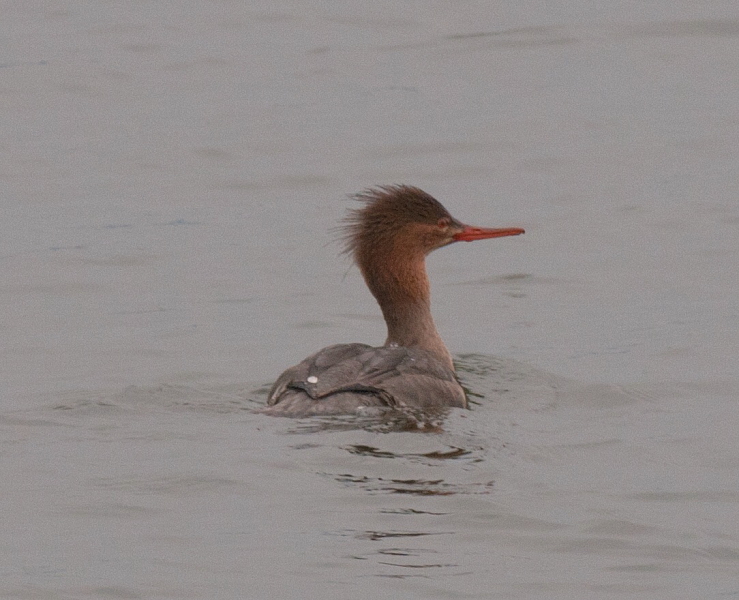
Thursday 28th February [A watery sun and a little bit milder than of late]
The Common Sandpiper Actitis hypoleucos remains on the dam and in the By-wash and there has been a small influx of Mute Swans Cygnus olor - we're up to 7 now. This afternoon I found a Slavonian Grebe Podiceps auritis over at The Island, viewed from the public footpath along Butcombe Bank. Later, I saw the Black-necked Grebe Podiceps nigricollis in the edge of the flooded trees at Wood Bay Point (when looking for the third time today). The Black-neck is in heavy moult to summer plumage but the Slav. is still in winter plumage. I have changed the status of Slavonian Grebe to very scarce (less than annual; typically every 2 or 3 years) rather than designating it as rare, because it has turned up in 2007, 2008, 2011-12, and 2013.